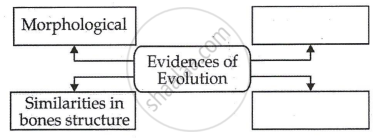Advertisements
Advertisements
Question
Vestigial organ ______ present in human body is proof of evolution.
Options
Human hand
Appendix
Ear muscles
Tail-bone
Gradual development
Mutation
Gene
Transcription
Translocation
Solution
Vestigial organ appendix present in human body is proof of evolution.
Explanation:
Appendix, which is useless to human, is useful and fully functional organ in ruminants. Similarly, muscles of ear pinna, which are useless to human, are useful in monkeys for movement of ear pinna. Various vestigial organs like tail-bone (coccyx), wisdom teeth, and body hairs are present in body of human being.
Notes
Above question has three possible answers, [Option (B), (C) and (D)].
RELATED QUESTIONS
If you are asked to select a group of two vegetables, out of the following, having homologous structures which one would you select?
(a) Carrot and radish
(b) Potato and sweet potato
(c) Potato and tomato
(d) Lady finger and potato
Select two pairs from the following which exhibit divergent evolution. Give reasons for your answer.
(i) Forelimbs of cheetah and mammals
(ii) Flippers of dolphins and penguins
(iii) Wings of butterflies and birds
(iv) Forelimbs of whales and mammals
Which of the following is a correct set of homologous organs?
(a) Forelimbs of frog, bird and lizard
(b) Spine of cactus and thorn of bougainvillea
(c) Wings of bat and wings of butterfly
(d) Wings of a bird and wings of a bat
Can the wing of a butterfly and the wing of a bat be considered homologous organs? Why or why not?
Attempt giving a clear definition of the term species.
Explain with an example for the given, how the following provides evidence in favor of evolution in organisms :
Analogous organs
There are five animals A, B, C, D and E. The animal A uses its modified forelimbs for flying. The animal B uses its forelimbs for running whereas the animal C uses its forelimbs for grasping. The animal D can live on land as well as in water and uses its forelimbs to prop up the front end of its body when at rest. The animal E which respires by using spiracles and tracheae uses wings for flying but its wings are analogous to the modified forelimbs of animal A.
(a) What could the animals A, B, C, D and E be?
(b) Why are the forelimbs of animals A, B, C, D called homologous organs?
(c) What does the existence of homologous organs in animals A, B, C and D tell us about their ancestors ?
(d) Why are the modified forelimbs of animal A and the wings of animal E called analogous organs?
(e) State whether animals A and E have a common ancestor or not.
In a class, students were asked to observe the models/slides/pictures of the skeletons of forelimbs and wings of different organisms. After the observations the students made the following groups of homologous structures. Select the correct group :
(A) Wings of a bird and a butterfly
(B) Wings of a pigeon and a bat
(C) Wings of a butterfly and a bat
(D) Forelimbs of a cow, a duck and a lizard
Write short notes based upon the information known to you.
Embryology
Write short notes based upon the information known to you.
Connecting link
Explain with suitable examples importance of anatomical evidence in evolution.
Answer the following question.
Wisdom teeth : Vestigial organs :: Lungfish : ....................
What do you mean by vestigial structures? Name four vestigial organs found in man.
Differentiate between connecting links and the missing links.
Very short answer question:
What is vestigeal organ?
Short answer question.
Give the significance of fossils.
_____________ is a vestigial organ in human beings.
Find an odd one out.
I am a connecting link between reptiles and mammals. Who am I?
The decaying process of C-14 occurs continuously in dead organisms only.
Give scientific reason.
Vertebrates have slowly originated from invertebrates.
Give scientific reason.
Duck-billed platypus shows relationship with mammals.
Write a short note:
Embryological evidences
Define the evidence of evolution shown in the figure.

What is carbon dating?
Select vestigial organs from the following.
Evolution has exhibited a greater stability of molecular structure when compared with morphological structures. Comment on the statement and justify your opinion.
Cucurbits do not develop thick and woody stem as they are:
Basic principles of embryonic development were pronounced by:
Evolutionary convergence is the development of:
The presence of gill slits, in the embryos of all vertebrates, supports the theory of ______.
The bones of forelimbs of whale, bat, cheetah and man are similar in structure, because ______.
Complete the following chart:

Give a scientific reason.
Morphological evidences suggest that dog, sheep and wolf have a common origin.
Complete the following conceptual picture:

Write names of some vestigial organs in the human body.
